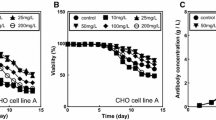Abstract
A major variable to consider in the production of biologicals from mammalian cell cultures is the mode of operation, be it a batch, continuous, perfusion, fed-batch or other production method. The final choice must consider a number of fundamental and economic issues. Here we present some antibody production data from different cell lines using different modes of production and discuss the important factors for consideration in choosing a production strategy. It was found that the productivity of batch cultures was lower than that obtained in continuous and perfused cultures, but that productivity could be improved by implementing suitable feeding strategies. The antibody productivity of one cell line, MCL1, during exponential phase was not affected by media type or glucose level. The maximum productivity of two cell lines in continuous culture was found to occur at dilution rates below the maximum, from 0.019 to 0.030 hr−1.
Similar content being viewed by others
References
Altshuler GL, Dziewulski DM, Sowek JA and Bellort G (1986) Continuous hybridoma growth and monoclonal antibody production in hollow fiber reactors. Biotechnol. Bioeng. 27: 646–658.
Butler M, Imamura T, Thomas J and Thilly WG (1983) High yields from microcarrier cultures by medium perfusion. J. Cell Sci. 61: 351–363.
Celltech Ltd. (1986) International Patent Application PCT/GB86/00383.
Fazekas de St. Groth (1983) Automated production of monoclonal antibodies in a cytostat. J. Immunol. Methods 57: 121–136.
Fletcher A, Harbour C and deZwart R (1984) Monoclonal antibodies specific for blood groups A and B. Aust. J. Exp. Biol. Med. Sci. 62: 421–428.
Glacken MW (1988) Catabolic control of mammalian cell culture. Bio/Technology 6: 1041–1050.
Glacken MW, Huang C and Sinskey AJ (1989) Mathematical descriptions of hybridoma culture kinetics. III. Simulation of fed-batch bioreactors. J. Biotechnol. 10: 39–66.
Harbour C and Fletcher A (1987) Blood grouping with monoconal antibodies. Develop. Biol. Stand. 67: 105–110.
Harbour C, Marquis CP, Barford JP and Walker KZ (in press) Stability of antibody secretion by hybridomas in Spier RE, Griffiths JB, Crooy P, and Stephens J. (eds) Advances in Animal Cell Biology and Technology for Bioprocesses, Butterworths, Guildford.
Klerx JPAM, Verplanke CJ, Blonk CJ and Twaalfhoven LC (1988) In vitro production of monoclonal antibodies under serum-free conditions using a compact and inexpensive hollow fibre cell culture unit. J. Immunol. Methods 111: 179–188.
Low KS, Harbour C and Barford JP (1987a) A study of hybridoma cell growth and antibody production kinetics in continuous culture. Biotechnol. Techniques 1: 234–244.
Low KS, Harbour C, Barford JP, deZwart R and Marquis CP (1987b) Hybridoma cell growth and antibody production kinetics. Aust. J. Biotechnol. 1: 59–63.
McQueen A, Meilhoc E and Bailey JE (1987) Flow effects on the viability and lysis of suspended mammalian cells. Biotechnol. Letts. 912: 831–836.
Merten O-W. (1988) Batch production and growth kinetics of hybridomas. Cytotechnology 1: 113–121.
Miller WM, Blanch HW and Wilke CR (1988) A kinetic analysis of hybridoma growth and metabolism in batch and continuous culture: effect of nutrient concentration, dilution rate and pH. Biotechnol. Bioeng. 32: 947–965.
Orlowski J and Barford JP (1987) The effect of inoculum preparation on fully aerated growth of S. Cerevisiae with a glucose substrate. J. Gen. Appl. Microbiol. 33: 113–121.
Reuveny S, Velez D, Miller L and Macmillan JD (1986) Comparison of cell propagation methods for their effect on monoclonal antibody yield in fermentors. J. Immunol. Methods 86: 86–95.
Reuveny S, Velez D, Miller L and Macmillan JD (1987) Factors affecting monoclonal antibody production in culture. Develop. Biol. Stand. 66: 169–175.
Takazawa Y, Tokashiki M, Murakami H, Yamada K and Omura H (1988) High density culture of mouse-human hybridoma in serum-free defined medium. Biotechnol. Bioeng 31: 168–172.
Tharakan JP and Chau PC (1986) A radial flow hollow fiber bioreactor for the large-scale culture of mammalian cells. Biotechnol. Bioeng. 28: 329–342.
Author information
Authors and Affiliations
Rights and permissions
About this article
Cite this article
Marquis, C.P., Harbour, C., Barford, J.P. et al. A comparison of different culture methods for hybridoma propagation and monoclonal antibody production. Cytotechnology 4, 69–76 (1990). https://doi.org/10.1007/BF00148812
Received:
Accepted:
Issue Date:
DOI: https://doi.org/10.1007/BF00148812




